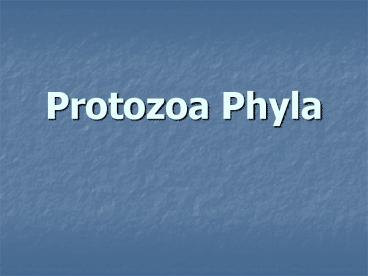Protozoa Phyla - PowerPoint PPT Presentation
1 / 34
Title:
Protozoa Phyla
Description:
Protozoa Phyla List of Phyla Amoeba-like organisms (e.g., Amoeba) Phylum Euglenozoa Subphylum Euglenida (e.g., Euglena) Subphylum Kinetoplasta (e.g., Trypanosoma ... – PowerPoint PPT presentation
Number of Views:1326
Avg rating:3.0/5.0
Title: Protozoa Phyla
1
Protozoa Phyla
2
List of Phyla
- Amoeba-like organisms (e.g., Amoeba)
- Phylum Euglenozoa
- Subphylum Euglenida (e.g., Euglena)
- Subphylum Kinetoplasta (e.g., Trypanosoma)
- Phylum Chlorophyta (e.g., Volvox)
- Phylum Apicomplexa (e.g., Plasmodium)
- Phylum Ciliophora (e.g., Paramecium)
3
General Characteristics
- Single-celled or unicellular organisms some live
in colonies - Size microscopic (3 to 1,000 microns).
- No germ layers, tissues, or organs
- However, specialized intracellular "organelles"
are present
4
General Characteristics
- Locomotion by pseudopodia, flagella, or cilia.
- Symmetry all types (bilateral, radial,
spherical, or asymmetrical) - Free living, commensal, parasitic, or mutualistic
- Mostly naked, but few have simple protective
exoskeletons (tests). Ex. Arcella
5
General Characteristics
- Nutrition autotrophic (holophytic), saprozoic,
saprophytic, or holozoic. - Reproduction asexual longitudinal and
transverse binary fission, budding, - Sexual sporogony, and autogamy
6
Amoeba-like organisms
7
Amoeba-like organisms
- Organisms move by pseudopodia, flagella, or a
combination - Monomorphic nuclei
- Genera
- Amoeba- without a test, naked
- Arcella- with a calcareous test
8
Figure 11.10
9
Amoeba
Pseudopod
Food Vacuole
Contractile Vacuole
Nucleus
Phagocytosis
Hyaline Cap
10
Figure 11.05
Amoeba hunting food
11
Arcella
Side View
Test
Pseudopod
12
Arcella
Nucleus
Top View
13
Phylum Euglenozoa
- Organisms move by one or two flagella
- Monomorphic nuclei
- Capable of photosynthesis chloroplasts usually
present
14
Subphylum Euglenida
- Plant like organisms
- Solitary
- Can photosynthesize
15
Euglena
16
Euglena
Chloroplasts
Contractile Vacuole
Flagellum not visible
Stigma
17
Subphylum Kinetoplasta
- Organisms are only heterotrophic
- No chloroplasts present
- all parasitic
Red Blood Cells
Trypanosoma smear cause of sleeping sickness
Organism
18
Trypanasoma
Trypanosoma organism
Red Blood Cells
19
Phylum Chlorophyta
- Flagellated single or colonial organisms
- Are autotrophic
- Have chloroplasts with chlorophyll
- Genetically different from Euglenozoa
20
Figure 11.20
Volvox life cycle
21
Volvox
Zygote
Egg
Mother Colony
22
Daughter Colonies
Mother Colony
Nuclei of individual cells
23
Phylum Apicomplexa
- organisms do not have locomotor structures
- all species are parasitic
- asexual reproduction involves schizogony
Plasmodium smear cause of Malaria
24
Final Host
Plasmodium agent For malaria
Vector
25
Ring stage
trophozoite
merozoite
Red blood cell
Trophozooite
26
Ring stage in red blood cell
Ring stage Early Trophozoite
27
Schizont with merozoites in red blood cell
Red blood cell
Merozoites in the Schizont
28
Female
Male
Gametocytes
29
Phylum CiliophoraThe Ciliates
- Organisms move by cilia
- Usually two sizes of nuclei
- Macronucleus and micronucleus
- Reproduction usually by transverse binary fission
- but sexual reproduction by conjugation
30
Paramecium
31
Binary Fission Asexual Reproduction
32
Conjugation sexual reproduction
33
Vorticella
34
Stentor































